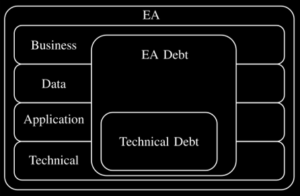Recently, Ada and Simon started the development of an ontology for Enterprise Architecture (EA) Debt. It delves into the nuances
Enterprise Architecture Debts - The Concept
Technical debt is a metaphor that had been introduced by Cunningham. In the software development industry, technical debt is regarded as a critical issue in terms of the negative consequences such as increased software development cost, low product quality, decreased maintainability, and slowed progress to the long-term success of developing software. Seaman et al. described technical debt as a situation in which software developers accept compromises in one dimension to meet an urgent demand in another dimension and eventually resulted in higher costs to restore the health of the system in future.
Over the years, technical debt becomes increasingly important when organizations invest huge amounts of money in IT to stay competitive, effective, and efficient. However, it is vital to align IT and business in order to realize the full benefits and potentials of those IT investments. From there, the concept of Enterprise Architecture (EA) has evolved as a method to facilitate the alignment of IT systems and business strategies within dynamic and complex organizations. Consequently, the huge interest in EA resulted in vast scientific contributions that address a broad thematic spectrum, including EA frameworks, EA management, and EA tools. However, there is a lack of insight into the application of the debt concept to include not only the technological aspects addressed by technical debt, but also the business aspects. Adapting the concept of technical debt to the EA domain, hitherto we have proposed a new metaphor “Enterprise Architecture debt (EAD)” to provide a holistic view:
Enterprise Architecture Debt depicts the deviation of the currently present state of an enterprise from a hypothetical ideal state.*
To clarify the relation between EA Debts, EA Smells, and Technical Debt, we reason on these terms. EA Smells are an equivalent to code smells in the domain of Technical Debt. Seaman and Guo consider code smells as a subset of Technical Debt grasping a certain aspect by providing a method for their detection. Accordingly, EA Smells detect qualitative shortcomings that are related to EA like the EA model as proposed by Salentin and Hacks. Other smells could also contribute to EA Debt like Code Smells. However, the contribution of a certain Code Smell to Technical Debt might be bigger than to EA Debt. For instance, god classes may not be an issue for EA Debt. This characterizes also the relation of Technical Debt to EA Debt. As Hacks et al. describe, the concept of EA Debt tries to provide a holistic view on the organization. Consequently, Technical Debt is a subset of EA Debt, as Technical Debt is focusing on technical aspects that are one of the dimensions of EA.

refer to the concept of Smells in general and EA Smells in special.
Related Work
Hacks, Simon; Hofert, Hendrik; Salentin, Johannes; Yeong, Yoon Chow; Lichter, Horst
Towards the Definition of Enterprise Architecture Debts Proceedings Article
In: IEEE 23rd International Enterprise Distributed Object Computing Workshop (EDOCW), pp. 9–16, IEEE, 2019, ISBN: 978-1-7281-4598-3.
@inproceedings{Hacks.2019,
title = {Towards the Definition of Enterprise Architecture Debts},
author = {Simon Hacks and Hendrik Hofert and Johannes Salentin and Yoon Chow Yeong and Horst Lichter},
doi = {10.1109/EDOCW.2019.00016},
isbn = {978-1-7281-4598-3},
year = {2019},
date = {2019-10-30},
booktitle = {IEEE 23rd International Enterprise Distributed Object Computing Workshop (EDOCW)},
pages = {9--16},
publisher = {IEEE},
abstract = {In the software development industry, Technical Debt is regarded as a critical issue in terms of the negative consequences such as increased software development cost, low product quality, decreased maintainability, and slowed progress to the long-term success of developing software. However, despite the vast research contributions in Technical Debt management for software engineering, the idea of Technical Debt fails to provide a holistic consideration to include both IT and business aspects. Further, implementing an enterprise architecture (EA) project might not always be a success due to uncertainty and unavailability of resources. Therefore, we relate the consequences of EA implementation failure with a new metaphor – Enterprise Architecture Debt (EA Debt).We anticipate that the accumulation of EA Debt will negatively influence EA quality, and expose the business to risk.},
keywords = {},
pubstate = {published},
tppubtype = {inproceedings}
}



